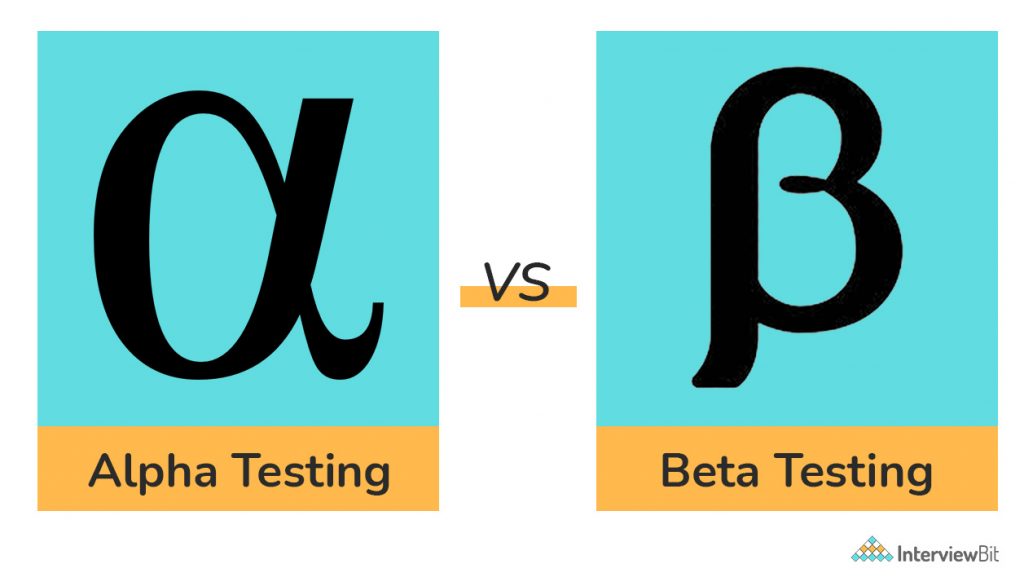- Introduction
- What is Alpha Testing?
- What is Beta Testing?
- Key Differences: Alpha Testing vs. Beta Testing
- Difference Between Alpha and Beta Testing: Tabular Difference
- Entry and Exit Criteria of Alpha Testing
- Entry and Exit Criteria of Beta Testing
- Pros and Cons of Alpha Testing
- Pros and Cons of Beta Testing
- Conclusion
- FAQs
- Q.1: What comes first, Alpha or Beta?
- Q.2: How long does alpha testing take?
- Q.3: How long does beta testing take?
- Q.4: Who is responsible for alpha testing?
- Additional Resources
Introduction
Consider a situation where you and your team developed software with lots of effort and hard work but after you delivered it to the client it contained loopholes and this happened due to a lack of testing that needs to be done for every software. It is important to perform various kinds of testing for your product to gain customer satisfaction and check software adaptability and functionality. Testing is the process of checking a system against various requirements that it is supposed to perform. It is an important step to be performed to ensure the quality of the product to be delivered. There is a variety of testing that is performed to achieve a quality product. Different types of testing are:
- User Acceptance testing
- Black Box testing
- End to End-testing
- Functional Testing
- Interactive Testing, and many more.
In this blog, we are going to discuss the two important types of testing, Alpha and Beta testing that come under User Acceptance testing. Both the testings are done on already tested products to get the real flavour of how the particular product will be used by real users. These two tests are based on the feedback of real users and different teams and it is achieved through different functionalities and techniques.
What is Alpha Testing?
It is one type of user acceptance testing. Its aim is to identify all the possible issues and errors that a product can generate and resolve all those issues before the final product is delivered to the end-user or to the public. This testing got its name alpha because it is performed at an early stage, close to the end of the software development life cycle but before beta testing.
Confused about your next job?
This kind of testing is performed by internal employees of the company that includes testers and Quality Analysts (QA) people. It is end-to-end testing done in a testing environment that makes sure the software developed meets all the expectations and works according to the requirements discussed at the start of development.
Alpha testing is carried out in two phases. The first phase is performed by software developers of the organization using some debugging software or tools. While the second phase is carried out by the testers or quality analysts. This phase covers black and white box testing also. Below is the process followed in alpha testing:
- Functional requirements and design specifications are reviewed.
- Developing test cases and test plans.
- Implementing those test plans.
- Defects raised from those test plans are then logged and informed to the developers.
- Developers resolve the defects raised and perform the testing once again.
Key Features of Alpha Testing
- Early identification of bugs in the design and functionality of the software.
- Imitation of real-time user environment.
- Helps in achieving better insights into software reliability at an early stage of development.
- More involvement of customers in the development process.
- Alpha Testing is performed at the developer’s site.
What is Beta Testing?
Beta Testing is also a type of acceptance testing that is done by a particular group of real users of the application. As it is the final stage of testing, it is done in production or a real environment. To achieve this type of testing the software is released to a few external members or customers who are not from the organization, they provide their feedback on the product’s design, functionality, and overall quality.
This testing is highly beneficial as we are getting direct reviews from the person who is actually going to use the product after its final release and it decreases the failure risk of software. There are various types of Beta testing like traditional beta testing, public beta testing, technical beta testing, and focused and post-release beta testing.
Key Features of Beta Testing
- No requirement for a testing environment.
- Beta testing checks for reliability, robustness, and security of software.
- It is performed in the end-user’s location.
- It is performed by real users outside the company.
- Beta testing commonly uses black box testing.
Key Differences: Alpha Testing vs. Beta Testing
- Alpha testing requires a testing environment whereas Beta testing doesn’t require any such environment.
- Alpha testing uses both black and white box testing while Beta testing uses only blackbox testing.
- Alpha testing is done by testers and quality analysts inside the organization whereas Beta testing is done by real users who will be actually using the software.
- Alpha testing takes a longer duration to complete execution while Beta testing gets completed within a few weeks.
- Alpha testing is done at the developer’s site while Beta testing is done at the client’s site.
- Alpha testing does not check the security and reliability of the product while Beta testing checks for the security and reliability of the product in depth by the end users.
- Multiple test cycles are organized in alpha testing while in beta testing only one or two test cycles are there.
Difference Between Alpha and Beta Testing: Tabular Difference

Following are some of the differences between alpha and beta testing:
| Alpha Testing | Beta Testing |
| This testing is performed by the employees of the organization | This testing is done by clients who are not part of the organization. |
| This kind of testing requires a specific environment for testing. | This does not require any environment for testing. |
| Robustness and security test is not performed in alpha testing | These parameters are checked during beta testing. |
| It is performed before the product launches into the market. | It is performed at the time of product marketing. |
| It performs many cycles to complete the testing. This may vary with the number of issues found. | It performs 1-2 cycles to complete the testing. This may vary with the user’s feedback. |
| The main goal is to evaluate the quality of the product | The main goal is to evaluate customer satisfaction. |
| Both white-box and Black-box testing are involved. | It only involves black-box testing. |
| Activities can be controlled since it’s performed on the developer’s site. | Activities can’t be controlled, since it’s performed in the real environment. |
| This testing is done by highly-skilled employees. They have knowledge about the software product. | This testing is done by the end-users. They don’t have the technical knowledge of the software product. |
| Stakeholders are the product management team, quality assurance team, and engineers. | Stakeholders are the product management team, user experience team, and quality management team. |
| Developers can resolve the bugs in alpha testing after testers inform them. | The feedback collected from the users is implemented in the future or in the next version of the application. |
Entry and Exit Criteria of Alpha Testing
Entry Criteria:
Entry criteria define the conditions that must be met before the testing is started. The following are mentioned for alpha testing:
- All the features of the software product are implemented and testable.
- No urgent bugs are present in the software product.
- All features are tested on the primary platforms.
- QA build is ready for execution.
- The testing team has good knowledge of the software application.
- The test environment is properly set up.
Exit Criteria:
Exit criteria define the conditions that must be met to complete the testing. The following are the exit criteria for alpha testing:
- Creating the report of any kind of serious bugs.
- Notifying the bug-fixing issues to the developers.
- Serious issues are fixed and closed.
- Not to include any additional features.
- Delivery of test summary report.
Entry and Exit Criteria of Beta Testing
Entry Criteria:
- Positive results from alpha testing.
- Environment ready to release applications in public.
- The bug in alpha testing has been addressed.
- Beta sites are ready for installation.
- Regression testing (software testing done to confirm if the recent changes have not affected the existing features) of the bug fix has been completed.
Exit Criteria:
- All kinds of bugs (major and minor) have been fixed.
- A report of all serious bugs has been created.
- Feedback reports from the public are ready.
- Notifying the raised issue to developers.
Pros and Cons of Alpha Testing
The following are the advantages of Alpha testing:
- This testing reveals the bugs that were not noticed during previous tests.
- It provides a better view of software reliability in the initial stages.
- It mimics the real-time user behaviour before going to beta testing.
- Serious errors are quite easily detected and resolved during this phase as testing is done at the developer’s site.
- This testing ensures that users will get a better experience while using the application.
- It analyzes the risks before the product launch.
The following are the disadvantages of Alpha Testing:
- Some functionalities get missed for testing as the software is still in the development phase.
- The difference between the tester’s perspective and the customer’s perspective can cause discrepancies in software functioning.
- Only business requirements are covered in alpha testing.
Pros and Cons of Beta Testing
The following are the advantages of Beta Testing:
- Improves the quality of the software with the end-user’s feedback.
- This testing increases customer satisfaction.
- Corner test cases are covered in this testing as applications are tested with all the possible cases by the users.
- It covers up the bugs that are revealed in previous tests.
- It is an opportunity to hand over the application to a few users before handing it over to the general public.
The following are the disadvantages of Berta Testing:
- Not all the participants assure you of the quality test.
- Reviewing the end user’s feedback is high.
- Not all the reviews are beneficial for the software product.
Conclusion
Testing is a crucial step for any of the applications. It is important to perform both the testing i.e. Alpha and Beta with proper and well-defined procedures to make the application a successful product to use. In the IT world, the software is not worth it unless it is tested by the developers and liked by the end users.
FAQs
Q.1: What comes first, Alpha or Beta?
Ans: The testing that is performed first is Alpha testing. This testing is performed by the internal people of the organization. After this comes the Beta testing that is performed by the real-world users and on the basis of the usage, they provide their feedback.
Q.2: How long does alpha testing take?
Ans: Typically, alpha testing takes 1-2 weeks per test cycle based on how many issues are discovered and how many new features are released. It’s not uncommon for the total Alpha phase to be 3-5x the length of the following Beta phase.
Q.3: How long does beta testing take?
Ans: Developers can spend 1-3 weeks on beta testing depending on the size of the app. The typical duration of a Beta Test will vary depending on its objectives.
Q.4: Who is responsible for alpha testing?
Ans: Alpha testing is done to check whether the product meets the business requirements. This is done by the internal employees of the organization in a testing environment. They are highly skilled in the technical knowledge of the application.
Additional Resources
- Software Testing MCQ
- Software Testing Interview Questions
- Principles of Software Testing
- Testing Tools
- Manual Testing Tools
- Automation Testing Tools
- API Testing Tools
- Performance Testing Tools
- Automation Testing Interview Questions
- Selenium Interview Questions
- Difference Between Testing and Debugging
- How To Become A QA Engineer?
- Test Plan vs Test Strategy
- Smoke vs Sanity Testing




